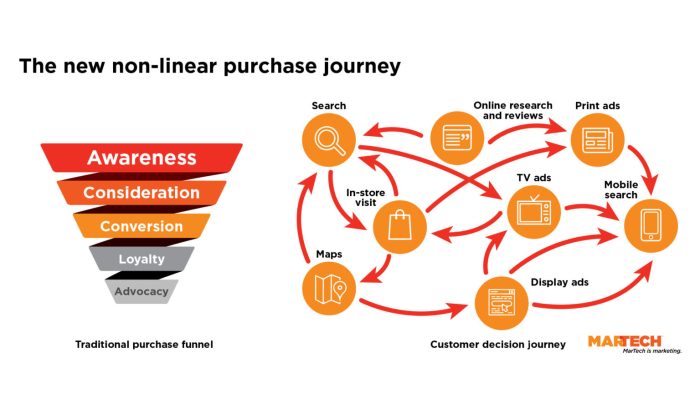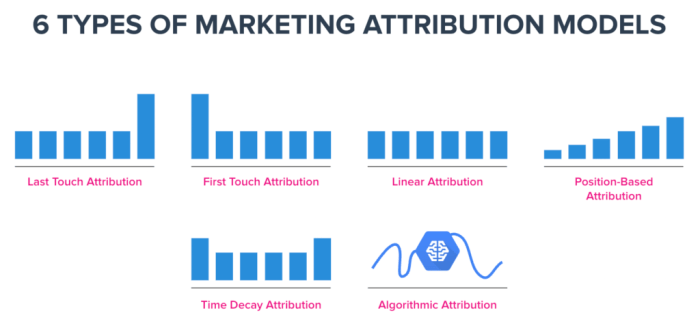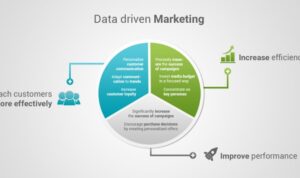Understanding Marketing Attribution Models dives into the world of analyzing touchpoints in the customer journey, shedding light on the crucial role of attribution in modern marketing strategies. Brace yourself for a journey through various models and their significance in the marketing realm.
Overview of Marketing Attribution Models

Marketing attribution is the process of determining which marketing channels or touchpoints contribute to a desired outcome, such as a sale or conversion. It helps marketers understand the effectiveness of their campaigns and allocate resources more efficiently.
Importance of Attribution Models
- Attribution models provide insights into the customer journey and help marketers identify the most influential channels.
- They enable businesses to optimize their marketing strategies by focusing on high-performing channels and improving ROI.
- Understanding attribution can lead to more accurate budget allocation and better decision-making.
Examples of Attribution Models
1. Last Click Attribution: Attributes all credit to the last interaction before a conversion.
2. First Click Attribution: Gives all credit to the first touchpoint in the customer journey.
3. Linear Attribution: Distributes credit equally across all touchpoints in the conversion path.
4. Time Decay Attribution: Gives more credit to touchpoints closer to the conversion and less to earlier interactions.
5. Position-Based Attribution: Attributes most credit to the first and last touchpoints, with the rest divided among the intermediate interactions.
Types of Marketing Attribution Models
When it comes to marketing attribution models, there are several types that businesses can utilize to understand the impact of different touchpoints in the customer journey. Each model comes with its own set of advantages and limitations, making it crucial for marketers to choose the one that best fits their needs and goals.
First Touch Attribution Model
The first touch attribution model gives credit to the first touchpoint that a customer interacts with before making a purchase. This model is useful for understanding how customers initially discover a product or service, but it may overlook the influence of other touchpoints further along the customer journey.
Last Touch Attribution Model
Conversely, the last touch attribution model assigns all credit to the final touchpoint that leads to a conversion. While this model provides a clear picture of what ultimately drives sales, it neglects the impact of earlier touchpoints that may have played a significant role in guiding the customer towards the purchase.
Linear Attribution Model
The linear attribution model evenly distributes credit among all touchpoints in the customer journey. This approach gives equal weight to each interaction, providing a more holistic view of how different touchpoints contribute to a conversion. However, it may oversimplify the impact of certain touchpoints that are more influential than others.
Time Decay Attribution Model
With the time decay attribution model, more credit is assigned to touchpoints that occur closer to the conversion event, while earlier touchpoints receive less credit. This model recognizes the diminishing influence of touchpoints over time but may undervalue the importance of initial interactions that shape the customer’s decision-making process.
Implementing Marketing Attribution Models: Understanding Marketing Attribution Models

Implementing marketing attribution models in a business setting is crucial for understanding the impact of different marketing channels on conversions. By setting up and tracking attribution models effectively, organizations can make informed decisions about their marketing strategies. However, there are challenges that organizations might face during implementation, which need to be addressed to ensure the success of the attribution model.
Best Practices for Implementing Marketing Attribution Models
- Define clear objectives: Before setting up an attribution model, clearly define what you want to achieve. Identify key performance indicators (KPIs) and goals for your marketing campaigns.
- Choose the right model: Select an attribution model that aligns with your business goals and the complexity of your marketing channels. Consider using a multi-touch attribution model for a more comprehensive view of the customer journey.
- Collect and integrate data: Ensure that you have access to accurate and reliable data from all your marketing channels. Integrate data from different sources to get a holistic view of your marketing performance.
- Test and iterate: Continuously test and refine your attribution model to improve its accuracy and effectiveness. Experiment with different models and parameters to find the best fit for your business.
Setting Up and Tracking Attribution Models Effectively
- Utilize marketing automation tools: Use marketing automation platforms to track customer interactions across different touchpoints. These tools can help you attribute conversions to specific marketing channels.
- Implement UTM parameters: Add UTM parameters to your marketing URLs to track the source of website traffic accurately. This will help you attribute conversions to specific campaigns or channels.
- Analyze customer touchpoints: Analyze the customer journey to understand how different touchpoints contribute to conversions. Identify the most impactful touchpoints and allocate credit accordingly.
Challenges and Solutions for Implementing Attribution Models, Understanding Marketing Attribution Models
- Data integration challenges: Organizations may face difficulties in integrating data from various sources. To overcome this, invest in data management tools that can consolidate and unify your marketing data.
- Lack of internal alignment: Different teams within an organization may have conflicting views on attribution. To address this, foster cross-department collaboration and communication to ensure everyone is on the same page.
- Over-reliance on last-click attribution: Many organizations still rely on last-click attribution, which may not provide a complete picture of the customer journey. Educate stakeholders about the limitations of last-click attribution and encourage the adoption of more advanced models.
Analyzing Results from Marketing Attribution Models
When it comes to interpreting and analyzing data gathered from various attribution models, businesses need to look at the bigger picture. By understanding how different touchpoints contribute to a customer’s journey, companies can make more informed decisions about their marketing strategies.
Insights from Analyzing Attribution Data
- Identifying the most effective marketing channels: By analyzing attribution data, businesses can determine which channels are driving the most conversions. This allows them to allocate resources more efficiently and focus on the channels that deliver the best results.
- Understanding customer behavior: Attribution models provide insights into how customers interact with different touchpoints before making a purchase. This information can help businesses tailor their messaging and content to better meet the needs of their target audience.
- Optimizing marketing campaigns: By analyzing attribution data, companies can optimize their marketing campaigns by adjusting the timing, messaging, and placement of ads. This ensures that marketing efforts are more targeted and effective.
Utilizing Insights for Marketing Optimization
- Personalizing the customer experience: With insights from attribution data, businesses can personalize the customer experience by delivering relevant content and offers based on customer behavior. This leads to higher engagement and conversion rates.
- Allocating budget effectively: By understanding which touchpoints contribute most to conversions, companies can allocate their marketing budget more effectively. This helps maximize ROI and drive better results from marketing efforts.
- Testing and iterating strategies: Attribution data allows businesses to test different marketing strategies and iterate based on performance data. This iterative approach helps companies refine their marketing tactics for continuous improvement.

